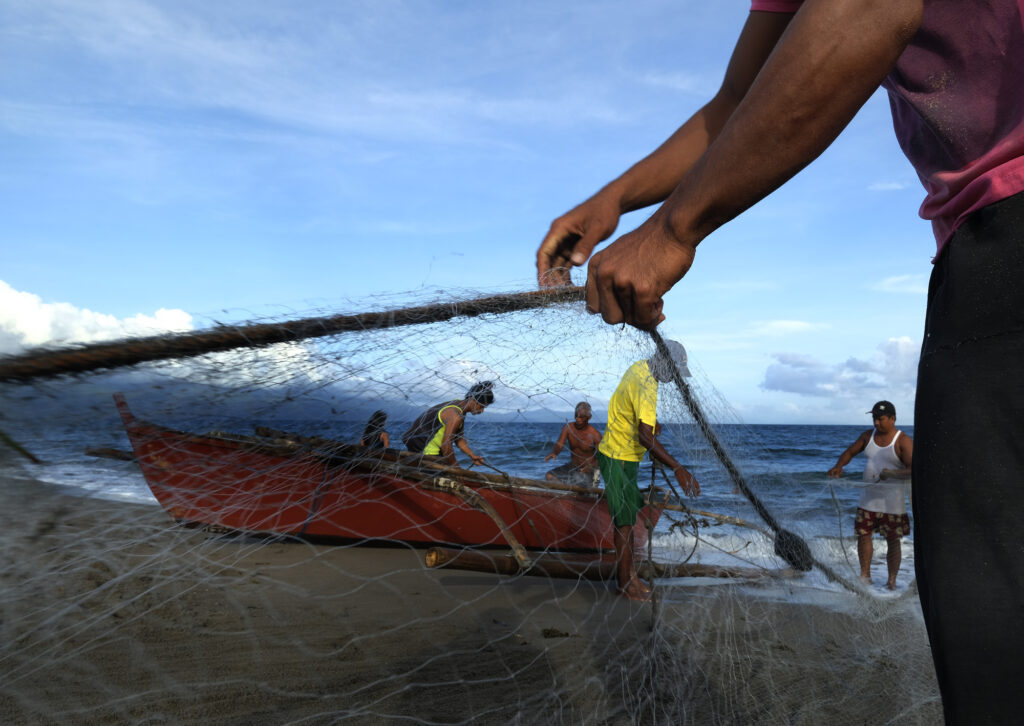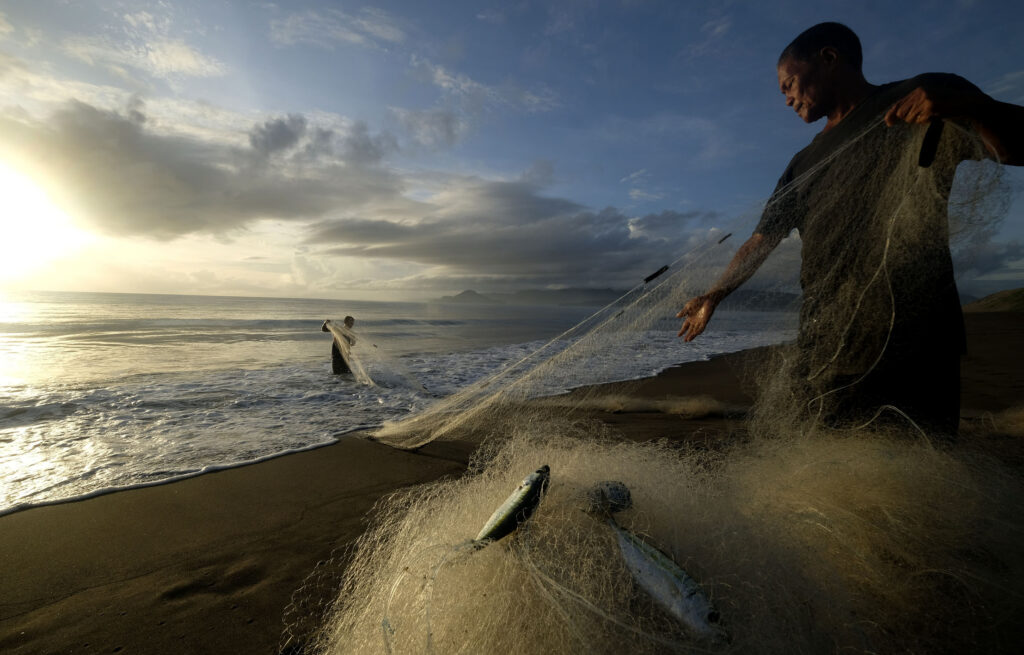By Henrylito D. Tacio
Photos by Rhoy T. Cobilla
Although the sun-drenched and beach-haven Philippines is a country with vast water resources, it is running out of fish. So much so that a “closed-fishing season” is observed during certain months of the year.
From November 15 to March 15, fishing sardines, herring, and mackerel in selected areas of the Visayas are strictly prohibited. In Davao Region, the government imposed a closed fishing season policy in Davao Gulf from June 1 to September 1.
The Bureau of Fisheries and Aquatic Resources (BFAR), a line agency of the Department of Agriculture, believes the “closed-fishing season” is one of the most significant legal instruments for managing fish stocks in the country.
In the Davao Gulf, Southern Mindanao’s fishing ground, the “closed-fishing season” is seen as a biological way to help improve the fish stocks due to a perennial decline in fish catch.
Davao Gulf is considered to be the 10th major fishing ground in the country. But fish stocks swimming in the waters are declining.
During the economic performance presentation in 2019, the National Economic Development Authority (NEDA) said there was a 7% decline in the output of the fishery sector in the region from P2.05 billion in 2017 to P1.9 billion in 2018.
Declining catch
This has confirmed the study conducted by the WorldFish Center some years back. A collaborative effort of the BFAR, local government units (LGUs), and the regional office of the Department of Science and Technology (DOST), the decade-study looked at the volume and quality of the harvests of 10 commonly fished species in the gulf: matambaka, tamban, moro-moro, caraballas, bilong-bilong, lapu-lapu, danggit, molmol, talakitok, and maya-maya.
Except for “maya-maya,” the harvest numbers for the species have been falling. “At the current rate of decline,” the study surmised, “the caraballas, bilong-bilong, molmol, and danggit may all disappear completely from Davao Gulf within a decade.”
To ensure that there’s a steady supply of fisheries in the market for the public as a result of the “closed-fishing season,” the agriculture department has approved the importation of 60,000 metric tons of fish in the last quarter of the year.

Fishermen in barangay Tagas, one of the 29 barangays of the Municipality of San Jose Camarines Sur. They rely on fishing as their source of income and major source of livelihood but can catch only two pieces of small fish even after so much hard work and wasted time. They would divide and bring the catch to their hungry families after fishing. Photos by Rhoy T. Cobilla 
“(The importation) is a balancing act to enhance and sustain the development of our fisheries sector as well as provide our fellow citizens affordable fish on their table,” said Agriculture Secretary William Dar.
According to Dar, the policy decision is the agriculture department’s way to ease the pressure on food inflation. “This (importation) benefits most of our poor countrymen whose purchasing power has been reduced due to the economic slowdown and the COVID-19 pandemic,” he explained.
Staple food
Fish is the country’s second staple food, next to rice. Fish provides more than half of the protein requirement of almost all Filipinos. On average, every Filipino consumes about 98.6 grams of fish and fish products, according to the Food and Nutrition Research Institute (FNRI).
“Fish protein is generally recognized as a valuable ingredient in a balanced diet,” said Dr. Veravat Hongskul, who was then the FAO regional fishery officer when interviewed by this author. “It is of high biological value and contains essential amino acids not normally found in staple food.
“The oil from the fish,” he continued, “also contains essential fatty acids, which are necessary for the proper development of the brain and the body. Where staple foods are available, a small quantity of fish can contribute significantly to increasing consumption by improving the overall palatability of the food and add to its nutritive value.”
During his time, French novelist Jules Verne suggested that when the world reached the limits of food production on land, man could turn to the oceans. Unfortunately, many countries have been doing just that over the past several decades.
“Between 1950 and 1989, the fish catch expanded more than four-fold, climbing from 22 million tons to 100 million tons,” Lester R. Brown reported in his feature, “Facing Food Scarcity.” “During the six years since then, the catch has leveled off. Contrary to the prognosis of Jules Verne, we reached the limits of the oceans first.”
Overfished
It is happening in the Philippines already. The major fishing grounds in the country are West Palawan waters, Sulu Sea, Visayan Sea, Moro Gulf, Davao Gulf, and others. From 1992 to 1995, these fishing grounds constituted more than 65% of the total commercial fishing catch. (The fishing industry provided employment to about one million Filipinos or around 3% of the country’s labor force in 1998.)
Today, the scenario has completely changed. Most of these fishing grounds are overfished.
Unless something is done soon, fish production may soon collapse. Dr. Salome Bulayog, an associate professor of the department of economics at the Visayas State University, said the aquatic marine resources of Sogod Bay in Southern Leyte, for instance, have been deteriorating in recent years.
Home to a variety of fishes, Sogod Bay, is a major fishing ground for the 11 municipalities that surround it. Mangko or frigate tuna (scientific name: Euthynnus affinis) is its major fishery resource. The seasonal influx of this shallow-water tuna species has provided food and livelihood to the people of Sogod and nearby municipalities.
“Frigate tuna used to abound in Sogod Bay and was a major source of income in the 70’s until the 90’s,” said Dr. Bulayog, who headed the study. “But today, fishermen could hardly catch fish.”
“Likewise, reef species population is also dwindling,” added the study. “Fishermen have to spend longer to catch a kilogram of fish; some even have to be farther from the shore.”
This is indeed bad news for fish-loving Filipinos. “We are running out of fish and running out of time. For a country known for marine biodiversity, there are very few fish left to catch,” deplored Vince Cinches, Oceans Campaigner for Greenpeace Southeast Asia.
“Like the other vital resources such as forests, Philippine fisheries are about to collapse,” deplored Jethro P. Adang, the director of Mindanao Baptist Rural Life Center (MBRLC), a non-government organization based in Bansalan, Davao del Sur.
Coastal ecosystems
Fishery experts claim that all fishing activities depend on a fragile resource base which, if mismanaged and overexploited, can easily collapse.
“The past three decades have seen the rapid decline of the Philippine coastal ecosystems,” Loren Legarda, then a senator said in a privilege speech some years back. Coastal ecosystems refer to mangroves, seagrasses, and coral reefs.
“Coral reefs, seagrass beds and mangroves are among the world’s most important and most endangered ecosystems,” says Dr. Miguel D. Fortes, a marine scientist, and the first Filipino to receive the prestigious International Biwako Prize for Ecology. “They are also the major life-support and protective ecosystems of the coastal zone.”
Coral reefs, for instance, are the marine equivalent of rainforests. The Philippines has 27,000 square kilometers of coral reef area within a 15- to 30-meter depth, one of the largest reef areas in the world. Almost 55% of the fish consumed by Filipinos depend on coral reefs; 10%-15% of the total marine fisheries production comes from coral reefs.
Yet, the country is losing its coral reefs. For instance, a survey conducted in 1991-1992 by the Regional Fishermen’s Training Center in Panabo, Davao del Norte at Sarangani Bay and Davao Gulf had shown that most of the shallow or inshore coral reefs “were totally damaged because they are exposed to greater pressure.”
Mangroves – communities of trees in the tidal flats in coastal waters, extending inland along rivers where the water is tidal, saline, or brackish – are not spared from denudation. Studies show 70% of the country’s mangroves are already destroyed.
Mangroves are very important to marine life. They are home to 68 species of fish (including bangus, kitan, tilapia, eel, and mullet, to name a few), 54 species of crustaceans (crabs, shrimps, and prawns), and 56 species of gastropods.
“Fish use the spaces under the mass of prop roots of mangrove trees as ‘delivery rooms,’ and the offspring of many marine species spend their growing period in the mangrove swamps before moving on to the open said,” says Dr. Rafael D. Guerrero III, a fishery expert and an academician with the National Academy of Science and Technology.
With the rampant mangrove denudation and coral reef destruction, seagrass beds – those discrete communities dominated by flowering plants with roots and underground stems – have become the “last frontier” of the country’s coastal resources.
“The whole central portion from low tide to the reef is inhabited by seagrass,” says Dr. Anitra Thorhaug, an American biologist who pioneered efforts in restoring seagrass habitats in the Philippines. “Yet corals and mangroves have reserved areas, seagrasses none.”
Seagrasses in the country cover an area of 27,282 square kilometers. They are widely distributed throughout the country – from Bolinao Bay (Pangasinan) in the north, Palawan and the Cebu-Bohol-Siquijor area to the center, and Zamboanga and Davao in the South.
“Seagrass beds are declining worldwide,” says Fortes. In the Philippines, 30%-50% of seagrass has been lost in the last 50 years.
Other causes
Aside from the destruction of coastal ecosystems, another factor that contributes to the depletion of fishery resources in the country is the siltation and sedimentation of the water ecosystem due to deforestation, mining, and other human activities.
“Besides bringing in poisonous and toxic substances into the water, silts and sediments lead to shallowing of the riverbeds killing phytoplanktons and other aquatic organisms, which are responsible for photosynthetic activities,” the Philippine Statistics Authority said.
Perhaps, by now, you know the reasons why the fish population is declining, and the fish catch is also dwindling.

